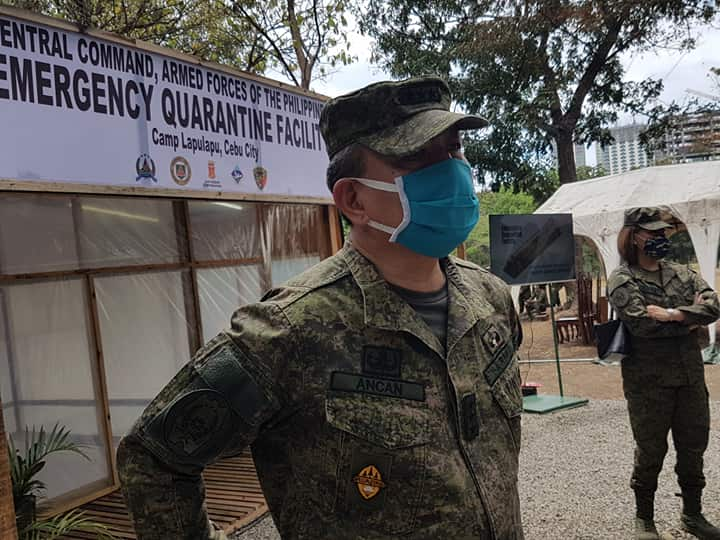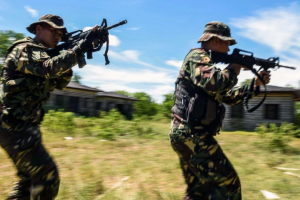
KILLED REBELS. Two communist New People’s Army rebels die during the series of armed encounters with the Army’s 26th Infantry Battalion Thursday (April 30) in the hinterlands of Barangay Guibonon, Esperanza, Agusan del Sur. Military officials have called on the remaining rebels in the mountains to return to the fold of the law and live peacefully with their families. (Photo courtesy of 26IB)
The series of clashes this week between the troopers of the Army's 26th Infantry Battalion and the communist New People’s Army (NPA) resulted in the killing of two rebels and the seizure of firearms and ammunition.
Lt. Col. Romeo C. Jimenea, 36Ib commander, said Saturday (May 2) the armed encounter took place in the hinterlands of Sitio Mahayon-hayon, Barangay Guibonon, Esperanza, Agusan del Sur Thursday (April 30).
Jimenea said the first encounter took place at 2 p.m. Thursday when the troopers responded to the reports of concerned residents in the area about the presence of the NPA.
“The rebels are now hungry as they have difficulties in securing food due to the continuing implementation of quarantines. The residents in the area were worried about their presence. The NPA is also planning to conduct atrocities as part of their offensive against the government,” Jimenea told the Philippine News Agency in a phone interview.
Jimenea said the first firefight that lasted for about seven minutes wounded a soldier on the right arm.
“Our troops pursued the NPA rebels when they retreated after the first encounter. The second encounter took place at around 10 p.m. in the vicinity of Sitio Mahayon-hayon,” the Army official said.
Two NPA rebels were killed on the second encounter that lasted for about 20 minutes, he added.
Following both clashes, Jimenea said the troops recovered two M16 rifles, one AK47 rifle, two bandoliers with eight long magazines and eight short magazines of M16 rifle loaded with ammunition, and one loaded magazine of AK47 rifle.
"I am commending the concerned citizens who reported to us on the presence of these terrorist NPAs. Through their coordination, we were able to immediately disrupt the planned atrocities of these lawless elements despite the attention that we are giving as front-liners on the health crisis that we are facing. If we weren't able to preempt the NPA's plan, it may cause additional burden to our constituents near the area,” Jimenea said.
He also urged the remaining NPA rebels to return to the fold of the law and avail of the program of the government intended for the former rebels.
Jimenea said the recovered dead bodies of the NPA rebels were turned over to the Philippine National Police and the local government for identification and burial.
The NPA is listed as a terrorist organization by the United Kingdom, the European Union, the United States, Australia, Canada, New Zealand, and the Philippines.
https://www.pna.gov.ph/articles/1101679
Lt. Col. Romeo C. Jimenea, 36Ib commander, said Saturday (May 2) the armed encounter took place in the hinterlands of Sitio Mahayon-hayon, Barangay Guibonon, Esperanza, Agusan del Sur Thursday (April 30).
Jimenea said the first encounter took place at 2 p.m. Thursday when the troopers responded to the reports of concerned residents in the area about the presence of the NPA.
“The rebels are now hungry as they have difficulties in securing food due to the continuing implementation of quarantines. The residents in the area were worried about their presence. The NPA is also planning to conduct atrocities as part of their offensive against the government,” Jimenea told the Philippine News Agency in a phone interview.
Jimenea said the first firefight that lasted for about seven minutes wounded a soldier on the right arm.
“Our troops pursued the NPA rebels when they retreated after the first encounter. The second encounter took place at around 10 p.m. in the vicinity of Sitio Mahayon-hayon,” the Army official said.
Two NPA rebels were killed on the second encounter that lasted for about 20 minutes, he added.
Following both clashes, Jimenea said the troops recovered two M16 rifles, one AK47 rifle, two bandoliers with eight long magazines and eight short magazines of M16 rifle loaded with ammunition, and one loaded magazine of AK47 rifle.
"I am commending the concerned citizens who reported to us on the presence of these terrorist NPAs. Through their coordination, we were able to immediately disrupt the planned atrocities of these lawless elements despite the attention that we are giving as front-liners on the health crisis that we are facing. If we weren't able to preempt the NPA's plan, it may cause additional burden to our constituents near the area,” Jimenea said.
He also urged the remaining NPA rebels to return to the fold of the law and avail of the program of the government intended for the former rebels.
Jimenea said the recovered dead bodies of the NPA rebels were turned over to the Philippine National Police and the local government for identification and burial.
The NPA is listed as a terrorist organization by the United Kingdom, the European Union, the United States, Australia, Canada, New Zealand, and the Philippines.
https://www.pna.gov.ph/articles/1101679





